1. Virtualized Infrastructure Manager¶
1.1. Prerequisites¶
Access to fabric management nodes
Basic services are available and configured
dhcpd
tftpd
httpd
coredns
registry
monitor
1.1.1. Requirements¶
Basic connectivity model using OOB NWs
Connectivity between DC Services and Nodes is available
1.2. Overview¶
The VIM is responsible for controlling and managing the NFV infrastructure (NFVI) compute, storage, and network resources, usually within one operator’s infrastructure domain. The VIM is a specific part of the MANO framework, but can have multiple instances in a network. There are two general kinds of instances. Some manage multiple types of NFVI resources, or they can be specialized to handle a certain type.
Management aspects concerning virtualized resources, including information, provisioning, reservation, capacity, performance and fault management. This scope of management concerns to the functionality produced by the VIM and exposed over the Or-Vi and Vi-Vnfm reference points.
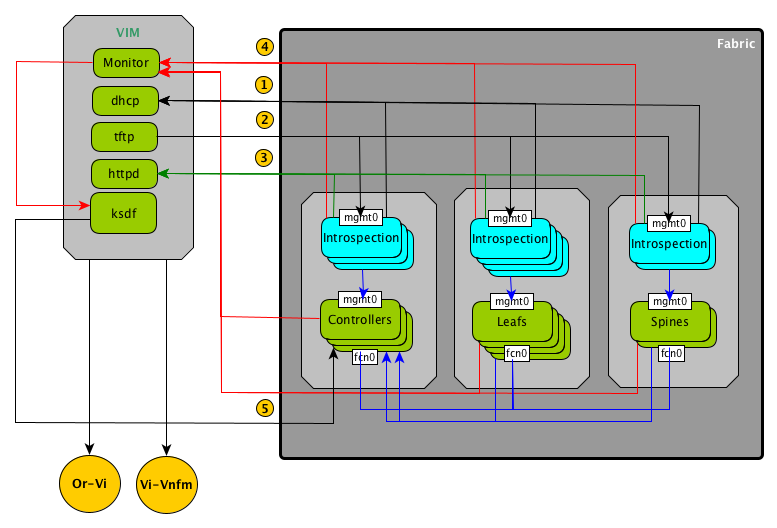
1.2.1. Stages¶
Fabric livecycle stages assume that the infrastructure is available and basic VIM services are available and reachable via OOB by all nodes.
Introspection
Node install including Basic Fabric and Keepalived static pods on all nodes
Create initial cluster
Decommission bootstrap and install the third controller
Add workers to the cluster
Deploy fabric services
Node Update
Node Decommissioning
1.3. Quick Start¶
If VIM is remote located, it is possible to create a L3 VXLAN tunnel between VIM and a node direct conneted to the fabric
Note
The underlay network could be either ipv4 or ipv6
On the VIM node
ip link add name vxlan42 type vxlan id 42 dev eth1 remote 2602:807:900e:141:0:1866:dae6:4674 local 2602:807:9000:8::10b dstport 4789
ip -6 address add fd02:9a04::1/64 dev vxlan42
ip link set up vxlan42
On the direct connected node:
ip link add name vxlan42 type vxlan id 42 dev mgmt0 remote 2602:807:9000:8::10b local 2602:807:900e:141:0:1866:dae6:4674 dstport 4789
ip -6 address add fd02:9a04::2/64 dev vxlan42
ip link set up vxlan42
Add a static route to svc0 network via VXLAN tunnel
ip -6 route add fd02:9a01::/64 via fd02:9a04::2 dev vxlan42
1.3.1. VIM node¶
Get the code
mkdir vim && cd vim
git clone --recurse-submodules -j8 https://gitlab.stroila.ca/slg/ocp/cluster.git
pushd cluster
git submodule update --remote
popd
Install basic services in the VIM node
pushd cluster
make clean && make deps
popd
1.3.2. PXE infrastructure nodes¶
Use Bios or iPxe method
1.3.3. Boostrap node¶
Patch etcd after api server is up
oc patch etcd cluster -p='{"spec": {"unsupportedConfigOverrides": {"useUnsupportedUnsafeNonHANonProductionUnstableEtcd": true}}}' --type=merge --kubeconfig /etc/kubernetes/kubeconfig
1.3.4. Master nodes¶
Ignite the two masters
curl http://registry.ocp.labs.stroila.ca/cfg/master.ign > /boot/ignition/config.ign
touch /boot/ignition.firstboot
reboot
1.3.5. Conver Bootstrap into Master¶
Ignite the third master
curl http://registry.ocp.labs.stroila.ca/cfg/master.ign > /boot/ignition/config.ign
touch /boot/ignition.firstboot
reboot
1.3.6. Approuve CSR’s¶
From VIM node
oc get csr --kubeconfig /opt/ocp/assets/auth/kubeconfig
For each “Pending” csr:
oc adm certificate approve <csr name> --kubeconfig /opt/ocp/assets/auth/kubeconfig
1.3.7. Verify the Installation¶
Verify cluster operators
[root@node-f01fafce5ded infra]# oc get co --kubeconfig /opt/ocp/assets/auth/kubeconfig
NAME VERSION AVAILABLE PROGRESSING DEGRADED SINCE MESSAGE
authentication 4.9.23 True False False 159m
baremetal 4.9.23 True False False 3h7m
cloud-controller-manager 4.9.23 True False False 3h23m
cloud-credential 4.9.23 True False False 4h8m
cluster-autoscaler 4.9.23 True False False 3h7m
config-operator 4.9.23 True False False 3h9m
console 4.9.23 True False False 162m
csi-snapshot-controller 4.9.23 True False False 3h8m
dns 4.9.23 True False False 3h6m
etcd 4.9.23 True False False 3h6m
image-registry 4.9.23 True False False 171m
ingress 4.9.23 True False False 165m
insights 4.9.23 True False False 168m
kube-apiserver 4.9.23 True False False 165m
kube-controller-manager 4.9.23 True False False 3h6m
kube-scheduler 4.9.23 True False False 3h6m
kube-storage-version-migrator 4.9.23 True False False 3h9m
machine-api 4.9.23 True False False 3h7m
machine-approver 4.9.23 True False False 3h7m
machine-config 4.9.23 True False False 166m
marketplace 4.9.23 True False False 3h7m
monitoring 4.9.23 True False False 164m
network 4.9.23 True False False 3h10m
node-tuning 4.9.23 True False False 3h7m
openshift-apiserver 4.9.23 True False False 165m
openshift-controller-manager 4.9.23 True False False 3h6m
openshift-samples 4.9.23 True False False 166m
operator-lifecycle-manager 4.9.23 True False False 3h7m
operator-lifecycle-manager-catalog 4.9.23 True False False 3h7m
operator-lifecycle-manager-packageserver 4.9.23 True False False 169m
service-ca 4.9.23 True False False 3h9m
storage 4.9.23 True False False 3h9m
Verify the cluster version
[root@node-f01fafce5ded infra]# oc get clusterversion --kubeconfig /opt/ocp/assets/auth/kubeconfig
NAME VERSION AVAILABLE PROGRESSING SINCE STATUS
version 4.9.23 True False 163m Cluster version is 4.9.23
Verify the cluster nodes
[root@node-f01fafce5ded infra]# oc get nodes -o wide --kubeconfig /opt/ocp/assets/auth/kubeconfig
NAME STATUS ROLES AGE VERSION INTERNAL-IP EXTERNAL-IP OS-IMAGE KERNEL-VERSION CONTAINER-RUNTIME
node-90b11c4c8bf6.montreal-317.slabs.stroila.ca Ready master,worker 3h13m v1.22.3+b93fd35 fd53:f:a:b:0:90b1:1c4c:8bf6 <none> Red Hat Enterprise Linux CoreOS 49.84.202202230006-0 (Ootpa) 4.18.0-305.34.2.el8_4.x86_64 cri-o://1.22.1-21.rhaos4.9.git74a7981.2.el8
node-b8ca3a6f3d48.montreal-317.slabs.stroila.ca Ready master,worker 3h13m v1.22.3+b93fd35 fd53:f:a:b:0:b8ca:3a6f:3d48 <none> Red Hat Enterprise Linux CoreOS 49.84.202202230006-0 (Ootpa) 4.18.0-305.34.2.el8_4.x86_64 cri-o://1.22.1-21.rhaos4.9.git74a7981.2.el8
node-b8ca3a6f7eb8.montreal-317.slabs.stroila.ca Ready master,worker 3h13m v1.22.3+b93fd35 fd53:f:a:b:0:b8ca:3a6f:7eb8 <none> Red Hat Enterprise Linux CoreOS 49.84.202202230006-0 (Ootpa) 4.18.0-305.34.2.el8_4.x86_64 cri-o://1.22.1-21.rhaos4.9.git74a7981.2.el8
1.4. Node Introspection & Installation¶
The introspection is a function of the VIM performed by in memory system boot using nested ignition which calls run-coreos-installer service. If it is successful, the run-coreos-installer service will install coreos on disk using a custom ignition and report back to the monitoring function via REST. If not will report the information about the faulty hardware.
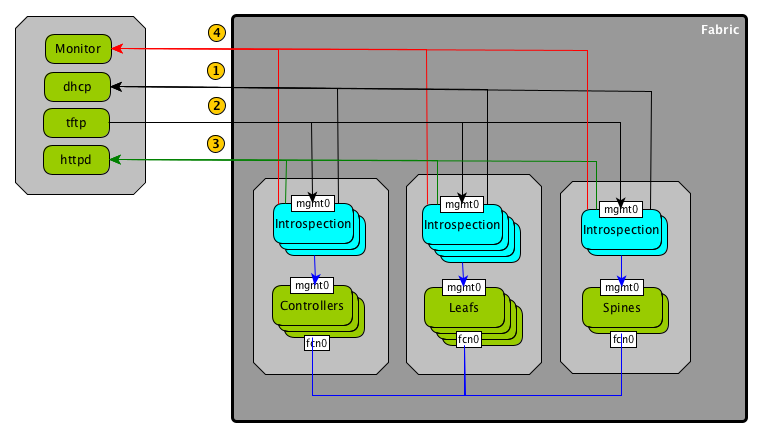
1.4.1. HardWare discovery/inspection library¶
1.4.1.1. Functions implemented:¶
getMemory()
getCpu()
getBlockStorage()
getTopology()
getNetwork()
getLocalAddresses()
getPci()
getDevices()
getGPU()
getChassis()
getBaseboard()
getProduct()
getSerialization()
Report example:
1 2 3 4 5 6 7 8 9 10 11 12 13 14 15 16 17 18 19 20 21 22 23 24 25 26 27 28 29 30 31 32 33 34 35 36 37 38 39 40 41 42 43 44 45 46 47 48 49 50 | processor core #0 (2 threads), logical processors [0 8]
processor core #1 (2 threads), logical processors [1 9]
processor core #2 (2 threads), logical processors [2 10]
processor core #3 (2 threads), logical processors [3 11]
processor core #4 (2 threads), logical processors [4 12]
processor core #5 (2 threads), logical processors [5 13]
processor core #6 (2 threads), logical processors [6 14]
processor core #7 (2 threads), logical processors [7 15]
capabilities: [msr pae mce cx8 apic sep
mtrr pge mca cmov pat pse36
clflush dts acpi mmx fxsr sse
sse2 ss ht tm pbe syscall
nx pdpe1gb rdtscp lm constant_tsc arch_perfmon
pebs bts rep_good nopl xtopology nonstop_tsc
cpuid aperfmperf pni pclmulqdq dtes64 monitor
ds_cpl vmx smx est tm2 ssse3
sdbg fma cx16 xtpr pdcm pcid
dca sse4_1 sse4_2 x2apic movbe popcnt
tsc_deadline_timer aes xsave avx f16c rdrand
lahf_lm abm 3dnowprefetch cpuid_fault epb cat_l3
cdp_l3 invpcid_single pti intel_ppin ssbd ibrs
ibpb stibp tpr_shadow vnmi flexpriority ept
vpid fsgsbase tsc_adjust bmi1 hle avx2
smep bmi2 erms invpcid rtm cqm
rdt_a rdseed adx smap intel_pt xsaveopt
cqm_llc cqm_occup_llc cqm_mbm_total cqm_mbm_local dtherm arat
pln pts md_clear flush_l1d]
#########################################################################
memory (48GB physical, 48GB usable)
#########################################################################
block storage (2 disks, 2TB physical storage)
dm-0 SSD (931GB) Unknown [@unknown (node #0)] vendor=unknown
sda SSD (932GB) SCSI [@pci-0000:00:1f.2-ata-1 (node #0)] vendor=ATA model=CT1000MX500SSD4 serial=2007E28A19AF WWN=0x500a0751e28a19af
sda1 (384MB) [ext4] mounted@/boot
sda2 (127MB) [vfat] mounted@/boot/efi
sda3 (1MB)
sda4 (932GB)
#########################################################################
topology SMP (1 nodes)
node #0 (8 cores)
L1i cache (32 KB) shared with logical processors: 0,8
L1i cache (32 KB) shared with logical processors: 1,9
L1i cache (32 KB) shared with logical processors: 2,10
L1i cache (32 KB) shared with logical processors: 3,11
L1i cache (32 KB) shared with logical processors: 4,12
L1i cache (32 KB) shared with logical processors: 5,13
L1i cache (32 KB) shared with logical processors: 6,14
L1i cache (32 KB) shared with logical processors: 7,15
L1d cache (32 KB) shared with logical processors: 0,8
L1d cache (32 KB) shared with logical processors: 1,9
|
1.4.2. Configuration¶
1.4.2.1. FCCT¶
fcct, the Fedora CoreOS Config Transpiler, is a tool that produces a JSON Ignition file from the YAML FCC file. Using the FCC file, an FCOS machine can be told to create users, create filesystems, set up the network, install systemd units, and more.
Create the FCCT definition file automated_install.yaml
1 2 3 4 5 6 7 8 9 10 11 12 13 14 15 16 17 18 19 20 21 22 23 24 25 26 27 28 29 30 31 32 33 34 35 36 37 38 39 40 41 42 43 44 45 46 47 48 49 50 51 52 53 54 55 56 57 58 59 60 61 62 63 64 65 66 67 68 69 70 71 72 73 74 75 | variant: fcos
version: 1.1.0
systemd:
units:
- name: run-coreos-installer.service
enabled: true
contents: |
[Unit]
After=network-online.target
Wants=network-online.target
Before=systemd-user-sessions.service
OnFailure=emergency.target
OnFailureJobMode=replace-irreversibly
[Service]
RemainAfterExit=yes
Type=oneshot
ExecStart=/usr/local/bin/run-coreos-installer
ExecStartPost=/usr/bin/systemctl --no-block reboot
StandardOutput=kmsg+console
StandardError=kmsg+console
[Install]
WantedBy=multi-user.target
storage:
files:
- path: /home/core/install
overwrite: true
contents:
inline: |
# This will trigger rhcos to be installed on disk
- path: /etc/hosts
overwrite: true
# A basic Ignition config that will enable autologin on tty1
contents:
inline: |
127.0.0.1 localhost localhost.localdomain localhost4 localhost4.localdomain4
::1 localhost localhost.localdomain localhost6 localhost6.localdomain6
{{VIM6}} vim.lab.stroila.ca vim
- path: /usr/local/bin/run-coreos-installer
overwrite: true
contents:
source: http://[{{VIM6}}]/ocp/run-coreos-installer.gz
compression: gzip
verification:
hash: sha512-{{run-coreos-installer}}
mode: 0755
- path: /usr/local/bin/ethtool
overwrite: true
# Deploys this tool by copying an executable from an https link. The
# file is compressed with gzip.
contents:
source: http://[{{VIM6}}]/ocp/ethtool.gz
compression: gzip
verification:
# The hash is sha512- followed by the 128 hex characters given by
# the sha512sum command. Append "sha512-"
hash: sha512-{{ETHTOOL}}
# Makes the tool file readable and executable by all.
mode: 0555
- path: /home/core/inventory
overwrite: true
contents:
source: http://[{{VIM6}}]/ocp/inventory.gz
compression: gzip
verification:
hash: sha512-{{INVENTORY}}
mode: 0555
- path: /usr/local/bin/dmidecode
overwrite: true
contents:
source: http://[{{VIM6}}]/ocp/dmidecode.gz
compression: gzip
verification:
hash: sha512-{{DMIDECODE}}
mode: 0555
|
Note
The sha512 verification is from the original file not the compressed resource
Pull the container for fcct
podman pull quay.io/coreos/fcct
Run fcct on the FCC file
podman run -i --rm quay.io/coreos/fcct:latest --pretty --strict < ./docs/source/config/automated_install.yaml > automated_install.ign
1.4.3. Static Pods¶
Static pods are included in the fabric ignition and are role and hardware specific.
keepalived static pod will be deployed in all the controllers in an active-active-active configuration that will monitor the apiserver.
1.4.4. Node install¶
The Node installation is triggered via nested ignition upon succesful node introspection
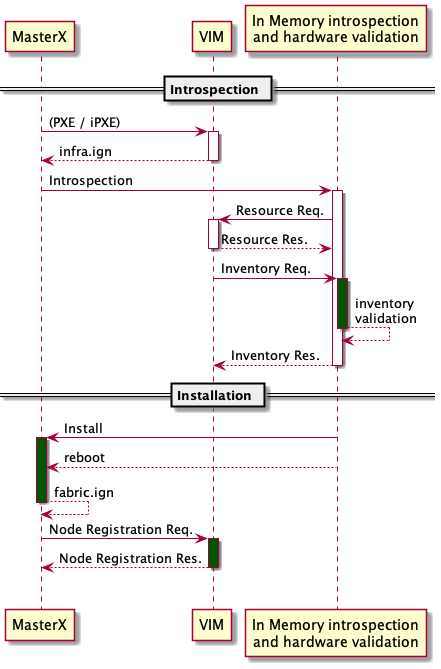
1.5. Create initial cluster¶
Select one of the controllers to act as a temporary deployment node.
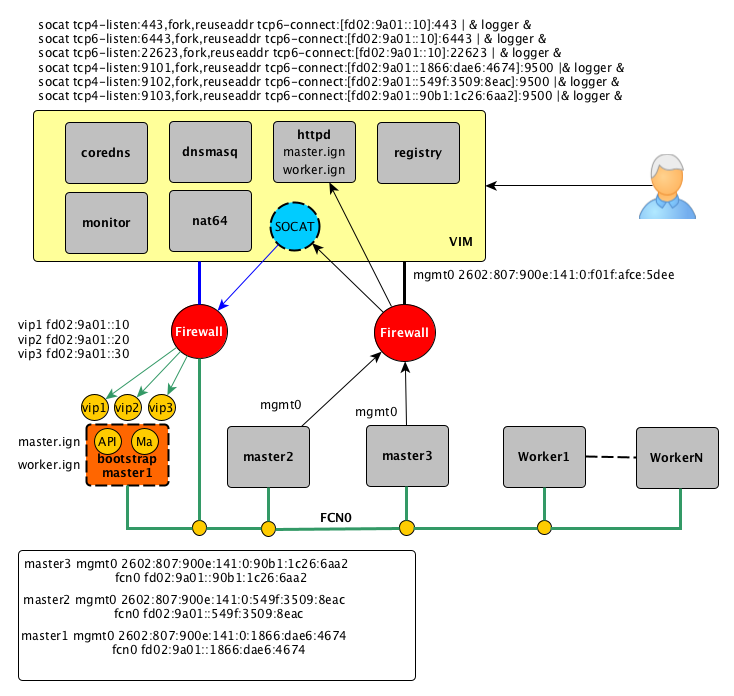
Sequence diagram describes how—and in what order—a group of objects works together
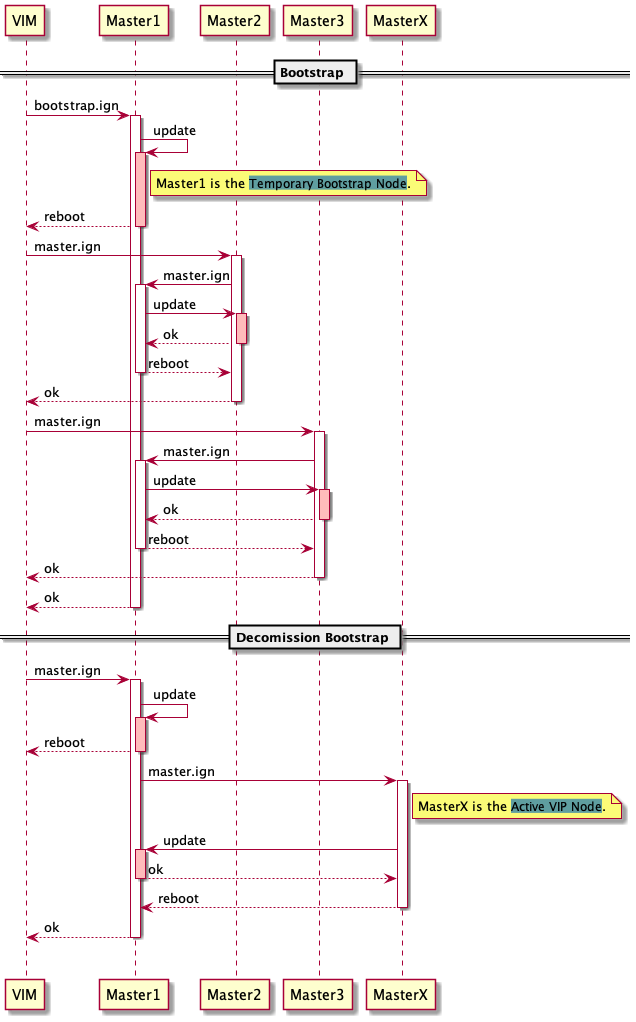
The desired state
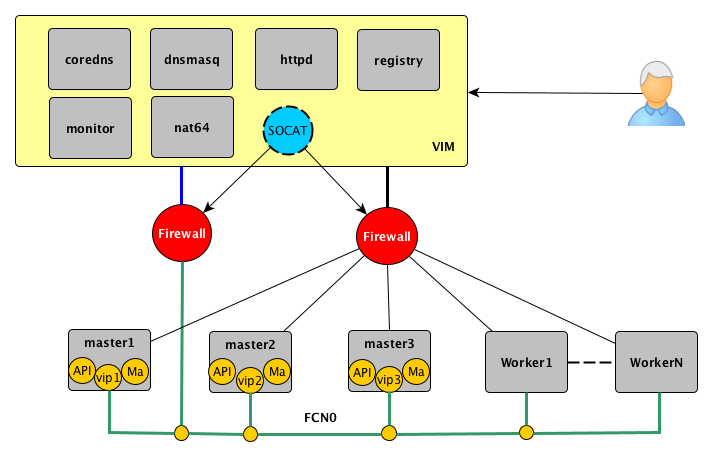
Note
The bootstrap stage can be executed in memory and after successful completion execute the OS install using a master ignition.
The cluster monitoring can be access from ipv4 network dashbord service via socat node_exporter running over ipv6
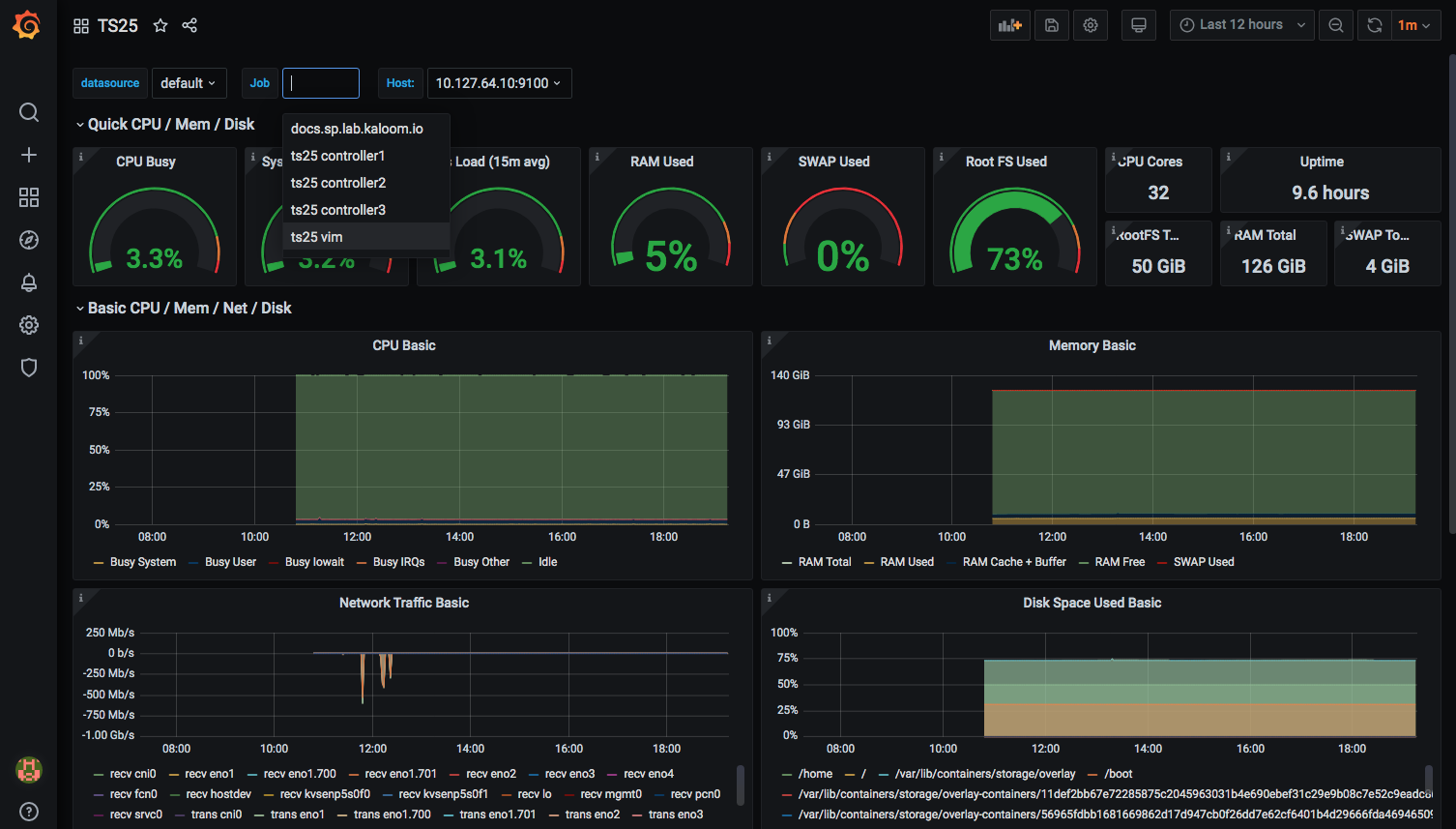
1.5.1. Socat¶
The socat utility is a relay for bidirectional data transfers between two independent data channels.
There are many different types of channels socat can connect, including:
Files
Pipes
Devices (serial line, pseudo-terminal, etc)
Sockets (UNIX, IP4, IP6 - raw, UDP, TCP)
SSL sockets
Proxy CONNECT connections
File descriptors (stdin, etc)
The GNU line editor (readline)
Programs
Combinations of two of these
There are many ways to use socat effectively. Here are a few examples:
TCP port forwarder (one-shot or daemon)
External socksifier
Tool to attack weak firewalls (security and audit)
Shell interface to Unix sockets
IP6 relay
Redirect TCP-oriented programs to a serial line
Logically connect serial lines on different computers
Establish a relatively secure environment (su and chroot) for running client or server shell scripts with network connections
Here we use socat to forward between IPv6 and IPv4 networks. The reason is to temporarly use VIM server as a port forwarder to reach bootstrap api and config machine services.
Examples
Redirect console
socat tcp4-listen:443,fork,reuseaddr tcp6-connect:[fd02:9a01::10]:443 |& logger &
Note
You need to add console-openshift-console.apps.ocp.labs.stroila.ca oauth-openshift.apps.ts25.labs.stroila.ca to /etc/hosts or dns
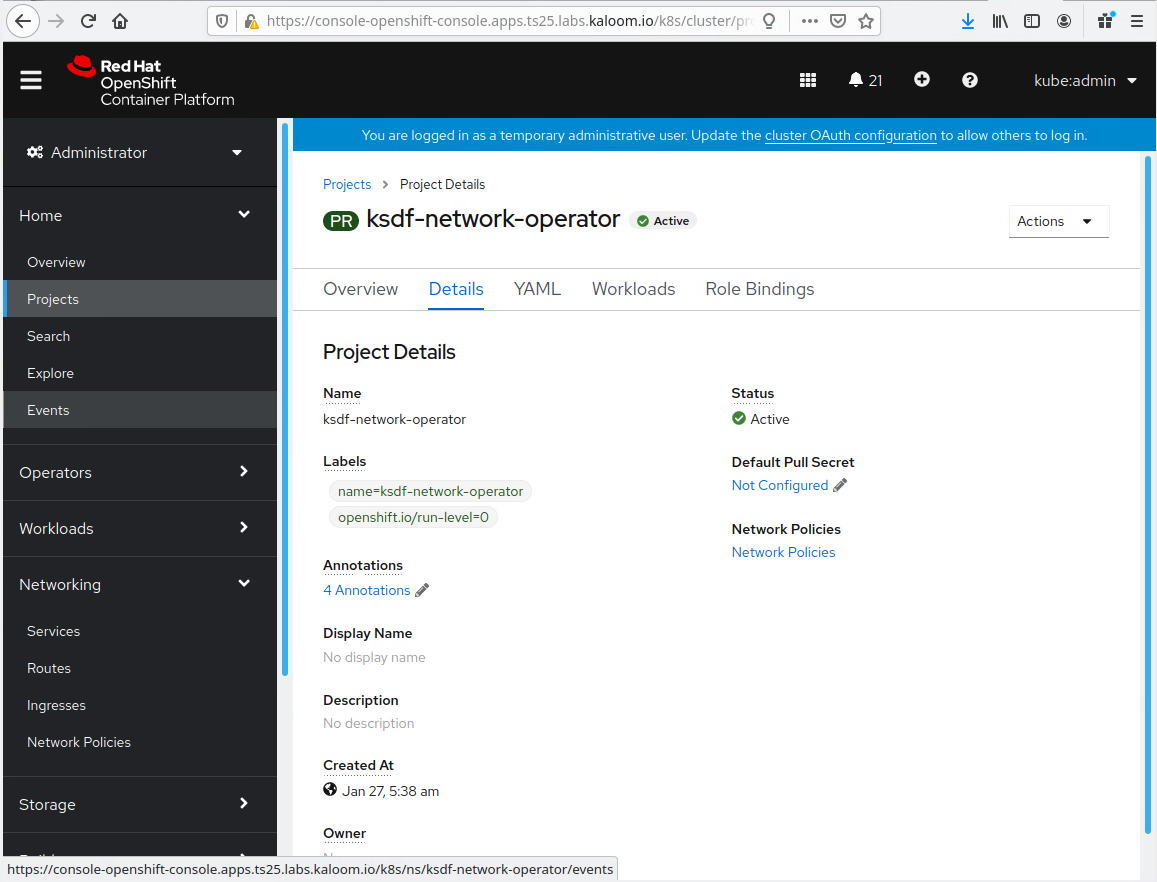
Redirect api and machine-config server
socat tcp6-listen:6443,fork,reuseaddr tcp6-connect:[fd02:9a01::10]:6443 |& logger &
socat tcp6-listen:22623,fork,reuseaddr tcp6-connect:[fd02:9a01::10]:22623 |& logger &
Redirect node_exporter from ipv4 to ipv6
socat tcp4-listen:9101,fork,reuseaddr tcp6-connect:[2602:807:900e:141:0:1866:dae6:4674]:9100 |& logger &
socat tcp4-listen:9102,fork,reuseaddr tcp6-connect:[2602:807:900e:141:0:549f:3509:8eac]:9100 |& logger &
socat tcp4-listen:9103,fork,reuseaddr tcp6-connect:[2602:807:900e:141:0:90b1:1c26:6aa2]:9100 |& logger &
Fake local DNS service
socat udp6-recvfrom:53,fork tcp:localhost:5353 |& logger &
socat tcp6-listen:5353,reuseaddr,fork udp6-sendto:[2602:807:900e:141:0:f01f:afce:5ded]:53 |& logger &
1.5.2. Bootstrap¶
curl http://registry.ocp.labs.stroila.ca/cfg/bootstrap.ign > /boot/ignition/config.ign
touch /boot/ignition.firstboot
reboot
etcd-quorum-guard should not attempt to deploy 3 replicas if useUnsupportedUnsafeNonHANonProductionUnstableEtcd is set. As soon as the API is available from the Bootstrap node, set useUnsupportedUnsafeNonHANonProductionUnstableEtcd
oc patch etcd cluster -p='{"spec": {"unsupportedConfigOverrides": {"useUnsupportedUnsafeNonHANonProductionUnstableEtcd": true}}}' --type=merge --kubeconfig /etc/kubernetes/kubeconfig
1.5.3. Master¶
curl http://registry.ocp.labs.stroila.ca/cfg/master.ign > /boot/ignition/config.ign
touch /boot/ignition.firstboot
reboot
System firstboot followd by reboot
machine-config-daemon-pull.service
machine-config-daemon-firstboot.service
1.5.3.1. Master from Bootstrap¶
curl -k https://api-int.ocp.labs.stroila.ca:22623/config/master > master.ign
1.5.4. Decommission bootstrap¶
Upon successful deployment of the initial controllers, the bootstrap node will reach out to the active controllers to fetch the master ignition to be installed on disk.
1.6. Add workers¶
Once the basic OCP cluster is up and running, the workers will be attached to the cluster.
1.7. Deploy fabric services¶
When the basic OCP deplyment is completed the fabric deployment services will be initiated.
1.8. Node Update¶
Providing the first node provisioning has basic RHCOS installed, iPXE chain load can be used to trigger node reinstallation using VIM services.
1.8.1. iPXE¶
Embedding via the command line
- For systems that do not have IPMI support there is a need for a method to trigger a fresh install especially for CICD use case.
This could be achived by embedding via the command line a script into an iPXE image loaded by GRUB:
timeout 10
default 0
title iPXE
kernel (hd0,0)/ipxe.lkrn dhcp && chain http://vimserver/boot.php
This uses a standard version of the iPXE binary ipxe.lkrn. You can change the embedded script simply by editing the GRUB configuration file, with no need to rebuild the iPXE binary. This method works only with iPXE binary formats that support a command line, such as .lkrn.
Note
You may need to escape some special characters to allow them to be passed through to iPXE.
Embedding via an initrd
You can embed a script by passing in an initrd to iPXE. For example, to embed a script saved as myscript.ipxe into an iPXE image loaded by GRUB:
timeout 10
default 0
title iPXE
kernel (hd0,0)/ipxe.lkrn
initrd myscript.ipxe
This uses a standard version of the iPXE binary ipxe.lkrn. The myscript.ipxe file is a plain iPXE script file; there is no need to use a tool such as mkinitrd. You can change the embedded script by editing the myscript.ipxe file, with no need to rebuild the iPXE binary. This method works only with iPXE binary formats that support an initrd, such as .lkrn.
1.9. Node Decommissioning¶
To remove a node from the cluster, node draining should follow the standard OCP procedure.